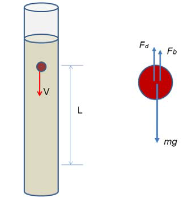
Use in Fluid Dynamics Ι lab.
A viscometer (also called viscosimeter) is an instrument used to measure the viscosity of a fluid. For liquids with viscosities which vary with flow conditions, an instrument called a rheometer is used. Viscometers only measure under one flow condition.
In general, either the fluid remains stationary and an object moves through it, or the object is stationary and the fluid moves past it. The drag caused by relative motion of the fluid and a surface is a measure of the viscosity.
The viscosity of a liquid at atmospheric temperature and pressure can be determined by timing the drop balls through some of the liquid. The experimental device used for this purpose, comprises of small solid balls, a meter and a stopwatch.
The viscometer is basically composed of a transparent cylinder. Above the mouth, and near its center, the small ball is dropped in the liquid of unknown viscosity, which fill the viscometer. When the ball falls into the liquid, the force of gravity, buoyancy and fluid resistance (drag) are exerted upon.
The small sphere falls in initially accelerated, as gravity dominates. However, as speed is increased, the resistance of the liquid is also increased, thus these three forces eventually reach at a balance, where the algebraic sum of these forces will be zero, and the sphere obtains a constant velocity soon after. In this case the resistive force will be given by the Stokes law.
The Stokes flow conditions must have a sufficiently small value of Reynolds number for there to be laminar flow, which is achieved when the sphere is small. Based on the Stokes relationship of the resistance force, the fluid viscosity can be calculated.
